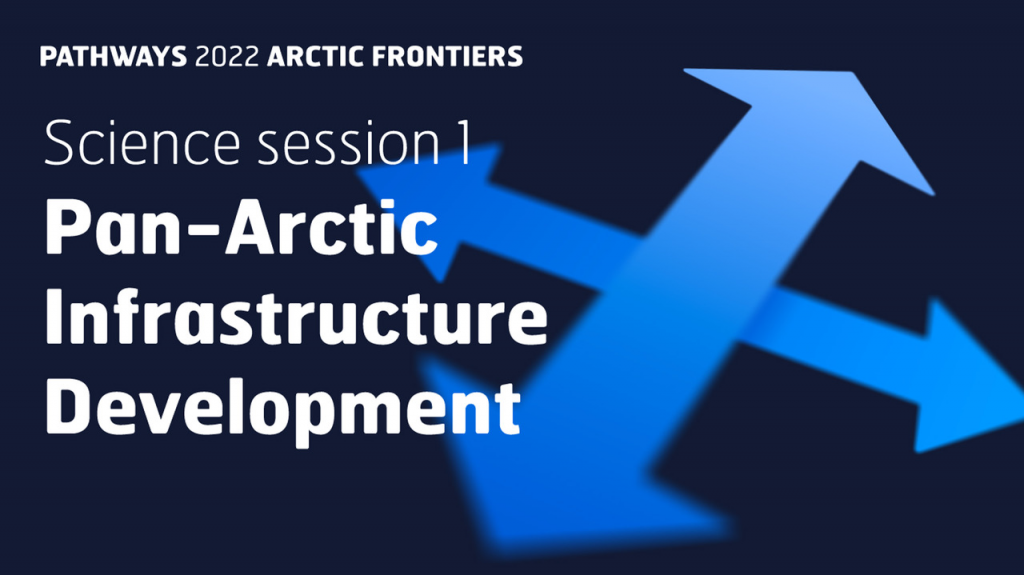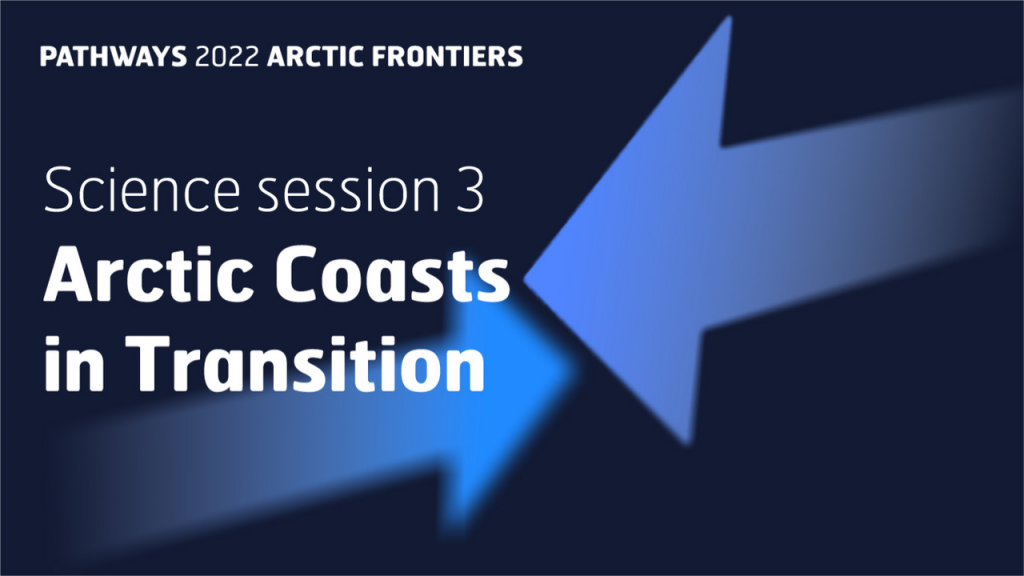
The theme of the 2022 Arctic Frontiers conference was Pathways. The conference had five Science themes covering a wide range of topics in physical and social sciences. Read more about the sessions here:
All the sessions were recorded and can now be watched for free on our YouTube channel:
Session Details
Session 1: Pan-Arctic Infrastructure Development
Sustainable development in the Arctic region to a large degree relies on the coupling of governance mechanisms and built infrastructure, which further involves technology and investment. There has been progress along these lines as well with evolving contributions from the Arctic Economic Council and considerations of an Arctic Investment Protocol, introduced by World Economic Forum Global Agenda Council on the Arctic to thoughtfully plan for an Arctic future that balances environmental protection, societal well-being and economic prosperity. The Arctic Infrastructure Inventory coordinated by the Wilson Center is another key step. The session of Pan-Arctic Infrastructure Development is intended to be holistic (international, interdisciplinary and inclusive) in the spirit of science diplomacy with its engine of informed decisionmaking to address questions of common concern, building common interests among stakeholders, rightsholders and other actors to balance economic, societal and environmental considerations across generations with inclusion.
We invited authors to submit abstracts addressing one or more of the following topics and case studies, related to the development of land, ocean, space, social, science, governance, cyber and other infrastructures. We particularly encouraged submission of presentations that consider short-to-long term planning and implications of infrastructure development, particulary with lessons to achieve progress with sustainability development on a Pan-Arctic scale that respects the Indigenous heritage of this globally-relevant region.
Session Committee:
- Paul Arthur Berkman
- Alexander Vylegzhanin
- Oran R. Young
- Mike Sfraga
- Anu Fredrikson

Session 2: Food from the Ocean and Ocean Science for Sustainable Development – Bridging the UN Decades

Starting in 2021, we are just at the beginning of the UN Decade of Ocean Science for Sustainable Development 2021-2030, capturing several societal objectives including, a clean ocean, a healthy and resilient ocean, a predictable ocean, a safe ocean, a sustainably harvested and productive ocean and a transparent and accessible ocean. Furthermore we are halfway in the UN Decade of Action on Nutrition 2016-2025, being a commitment of the members of the United Nations to undertake 10 years of sustained and coherent implementation of policies, programs and increased investments to eliminate malnutrition in all its forms, everywhere and without leaving anyone behind. Food from the Arctic has great potential to contribute significantly to reach the objectives targeted in the UN Decade of Action on Nutrition 2016-2025 and the objectives of the UN decade of Ocean Science for Sustainable Development are key to ensure sustainable food production systems from the ocean in the future.
The ocean is unquestionable a pillar of life, as well as an under-recognized provider of nutritious food and livelihoods. This especially applies to the Arctic with its great potential to contribute to sustainable food production. Increased global availability and consumption of aquatic food may prevent hidden hunger, malnutrition and help combat non-communicable diseases and thereby help to establish food security. Aquatic foods are also very important contributors to the ongoing dietary proteins shift, where today an exchange of red meat in favor of green protein sources has been the dominating trend. The micronutrient profile and bioavailability of “blue” proteins is however far stronger than for many green alternatives, calling for a more diverse protein shift to avoid e.g. expansion of iron deficiency.
Thus, it is timely to start a discussion on how to increase the food production, including from the Arctic, to contribute to food security and nutrition, locally and globally, and at the same time preserving the integrity of the marine ecosystem. The food produced needs to be safe, nutritious, accessible and culturally acceptable. As food insecurity amongst Arctic populations is high, we also need to consider how harvesting in the Arctic can feed the Arctic people.
The potential of an increased seafood production may include, but not be limited, to the harvest and aquaculture of low-trophic organisms, better utilization of small pelagic species in food production, exploitation of new marine resources for either direct human consumption or to enhance the marine biomass in fish feed.
Future sustainable food production systems include feed and food from land and sea, and we also need to establish commonly accepted methods to assess the total footprint of the various products from the ocean.
This session examined food from the Arctic and evaluated the potential for an increase in production and harvest. What are the main opportunities and challenges? How can the production of food from the ocean be increased/sustained whilst not interfering with ocean health?
Session committe:
- Martin Wiech, Institute of Marine Research
- Karl-Erik Eilertsen, UiT- The Arctic University of Norway
- Narcisa Bandarra, Portuguese Institute for the Sea and Atmosphere,I.P. IPMA
- Jónas R. Viðarsson, Matís ltd., Iceland
- Shirley Tagalik, Aqqiumavvik Society
- Ingrid Undeland, Chalmers University of technology
Session 3: Arctic Coasts in Transition
The pan-Arctic coast is undergoing dramatic interrelated physical, biogeochemical, ecological and socio-economic changes. Climate change-related factors such as increasing air temperatures, changes in precipitation patterns, declining sea ice, melting glaciers, permafrost thaw, coastal erosion and increased frequency of extreme weather events are accelerating the reshaping of Arctic coastlines, and leading to strong changes in fluxes of freshwater and terrestrial material from land to sea. These rapid changes are occurring alongside changes in human activity and land-use along the Arctic coast (e.g. increased tourism, industrial development), transforming coastal ecosystems and creating significant challenges, but also new opportunities, for local communities.
This session aimed to connect researchers, indigenous partners and community members who are studying, predicting, modelling and living with these dramatic coastal and nearshore changes across the Arctic. This session’s aim was to foster knowledge exchange and dialogue on how best to mitigate and adapt to ongoing changes and will help to identify research priorities that encourage the joint production of knowledge to support local efforts to mitigate losses, capitalize on new opportunities, and build resilient communities.
This was a highly interdisciplinary session, including perspectives from across the Arctic, and welcomed contributions on topics including, but not limited to: 1) environmental and societal drivers of Arctic coastal change; 2) physical change of Arctic coasts–coastal dynamics and rates of change; 3) impacts on coastal ecosystems and local Arctic communities; and 4) supporting sustainable planning, management, mitigation and adaptation measures for an Arctic coast in transition.
Session committee:
- Amanda Poste (Session lead), Norwegian Institute for Water Research / UiT–The Arctic University of Norway.
- Hugues Lantuit (session co-lead), University of Potsdam / AWI; Germany
- Ken Dunton, University of Texas Marine Sciences Institute
- Grete Hovelsrud, Nord University
- Gestur Hovgaard, Grønlands Universitet
- Maria Jensen, University Centre in Svalbard
- Gleb Kraev, Yamal-Nenets Center of Arctic Research
- Alexandra Meyer, University of Vienna
- Maeve McGovern, Norwegian Institute for Water Research / UiT–The Arctic University of Norway
- Joan Nymand Larsen, University of Akureyri
- Paul Renaud, Akvaplan-niva
- Janne Søreide, University Centre in Svalbard

Session 4: The Arctic, Ocean Conflicts, and Pathways to Sustainability

Following the Rio + 20 UN conference in 2012, Blue Economy and Blue Growth have become increasingly popular concepts. Internationally, a number of strategies have been formulated to highlight and exploit the growth potential related to marine and coastal areas. While these emphasize sustainable development, the focus on Blue Growth seems to accelerate the long-term industrialization of the oceans, leading to increased political interest to extend ocean management and control. In the wake of this, conflicts tend to arise on many levels.
In the Arctic, there is already blue growth in another sense. Here, the sea ice is declining in extent and thickness, and during this century, nearly ice-free conditions and blue seas are expected at least during parts of the year. This will make the marine Arctic more accessible and contribute to greater activity and attention. As in other ocean areas, latent conflicts are very likely to escalate and new ones to emerge.
Ocean conflicts are multifaceted and can occur between different types of activity, between use and conservation, between local communities and external interests, between different states, and between different governance regimes. More specifically, conflicts can be about access to areas, rights to natural resources, terms of use or non-use, distribution of benefits and costs, political demands for recognition and co-determination, and geopolitics and territorial sovereignty. Many of these conflicts are already common to the Arctic coastal states, but they can be amplified in the Arctic, where new and cooperative solutions are required to ensure sustainability.
This session analyzed the Arctic in an international, comparative perspective and took a broader look at marine conflicts, conflict transformation, and pathways to sustainability. What are the biggest challenges in the Arctic? What lessons can be learned about the handling of conflicts both in the Arctic and from other parts of the world? How can conflicts and conflict resolution contribute to increased sustainability?
Session committee:
- Maaike Knol-Kauffman, University of Tromsø – The Arctic University of Norway (lead)
- Andreas Østhagen, Fridtjof Nansen Institute
- Timo Koivurova, University of Lapland
- Dmitriy Tulupov, St. Petersburg University
- Emily Tsui, University of Toronto
- Alina Bykova, The Arctic Institute
Session 5: Experiences from the Science-Policy Interface in the Arctic
In the Arctic, the ambition towards reaching the UN sustainable development goals is high on the political agenda, in parallel with the objective for both blue and green growth. However, sustainable development is complex and multifaceted, and requires considerations of synergies and trade-offs when balancing growth, development and socio-ecological sustainability, and relies on joint efforts from decision makers, lawyers, scientists, industry and citizens alike. Hence, successfully navigating sustainable development in the Arctic will require the integration of scientific, local and indigenous knowledge, approaches for understanding social well-being, and the integration of different stakeholder perspectives in order to inform management and decision-making processes.
This session aimed to shed light on approaches that can support sustainable development through the collection of various types of knowledge, methods to assess socio-ecological well-being, approaches to knowledge co-production, and co-management, to contribute to inclusive, and well-informed decision-making.
Session committee:
- Charlotte Teresa Weber and Trude Borch, Akvaplan-niva (Co-leads)
- Arthur Mason, NTNU
- Astrid Høgestøl, Norwegian Polar Institute
- Maria Kalinina, UArctic & NArFU
- Jon Fuglestad, Research Council Norway
- Froukje Maria Platojouw, NIVA
- Sibyl Diver, Stanford University, Stanford University
